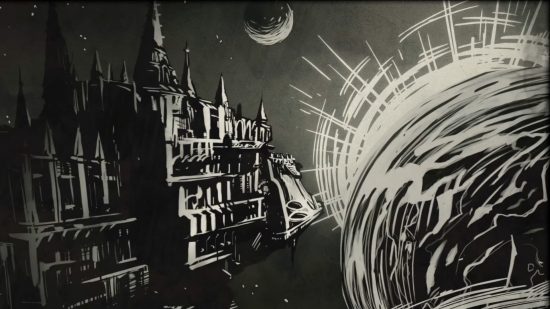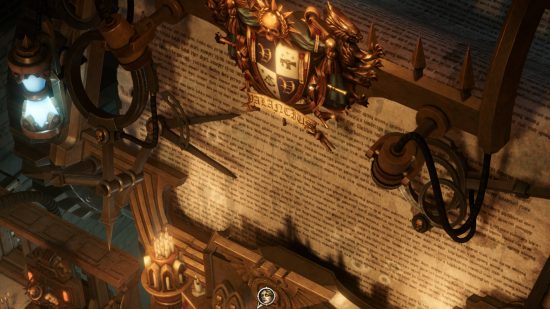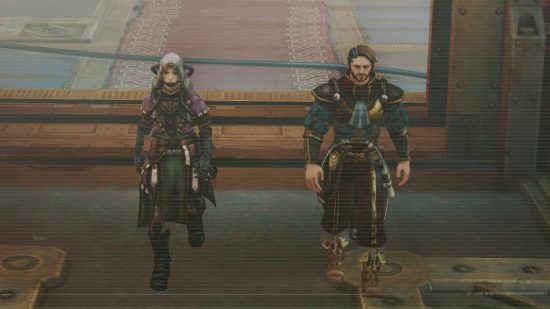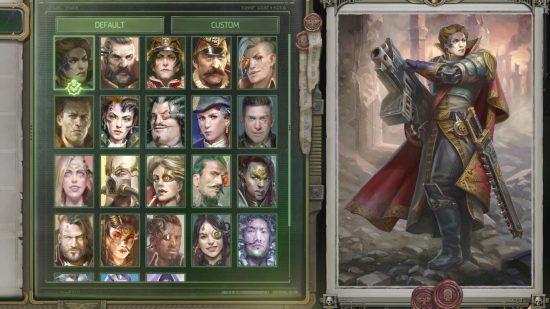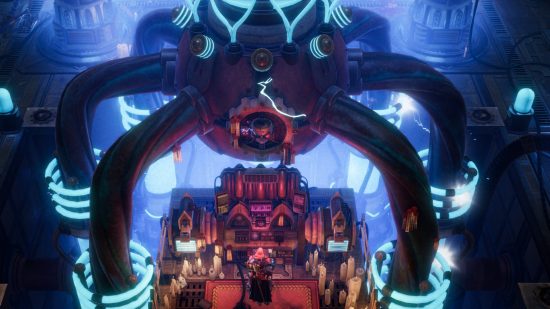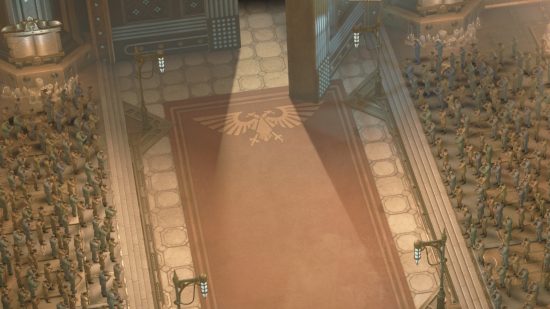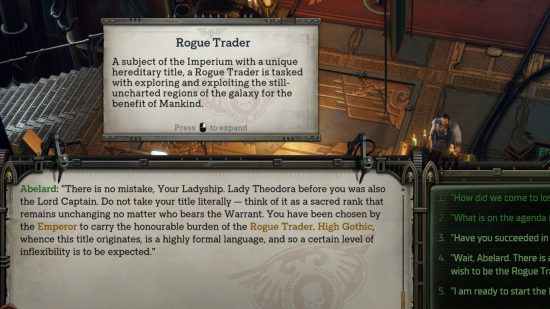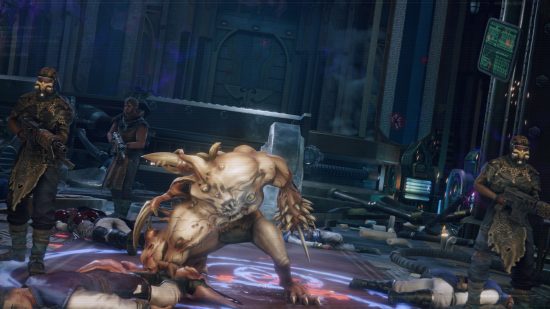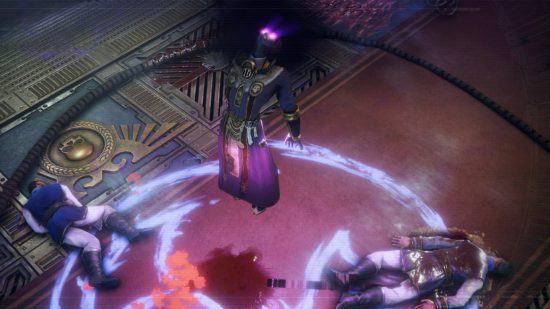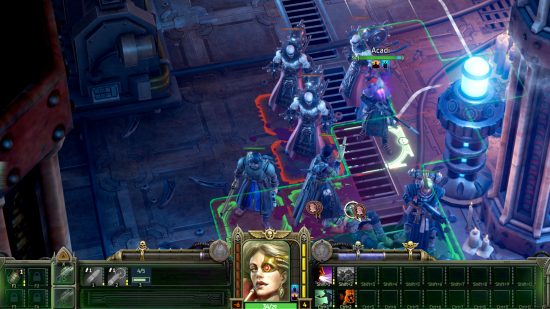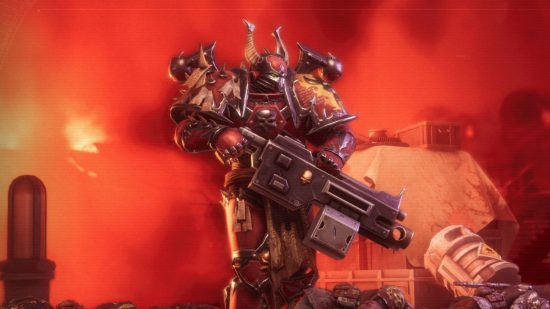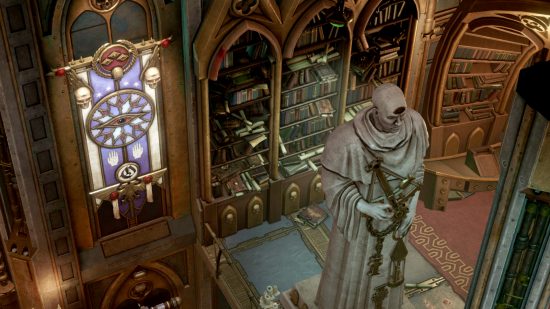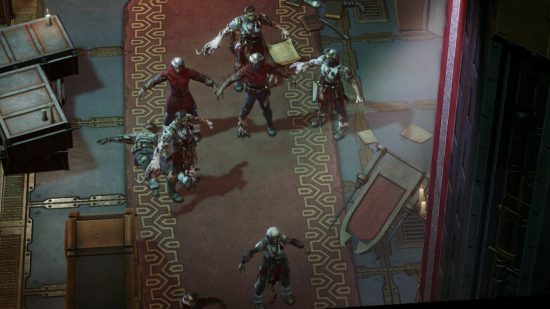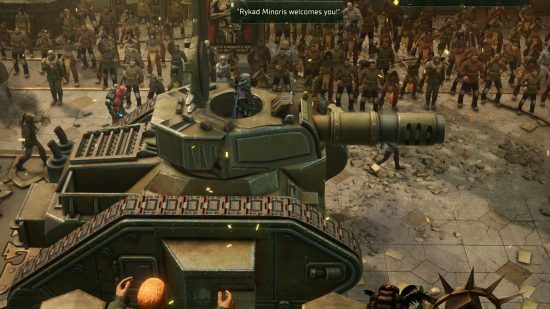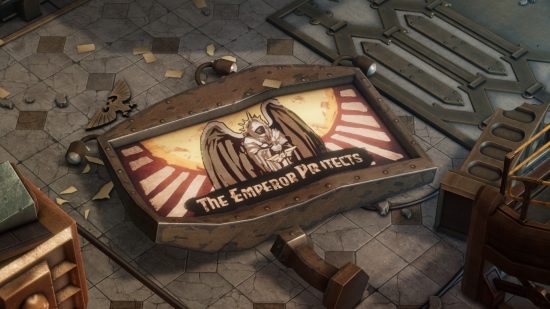Ever since its announcement, Warhammer 40k: Rogue Trader has filled me with equal parts of wide-eyed excitement and anxious dread. A lore-rich, story driven Warhammer 40,000 RPG and detailed, tabletop-style tactical combat and world-building that authentically simulates the scale, power, and freedom of commanding a 40k voidship is a vast, intoxicating promise. After 20 hours in-game, I’m ready to share my report – and Lord Captain, the auguries are mostly good.
Before we get into the (only mildly warp-tainted) meat of my Rogue Trader review, we need to get three (3) things straight. First: this is most certainly a ‘review in progress’, and we won’t be awarding a final review score just yet.
Developer Owlcat says a full campaign of Warhammer 40k Rogue Trader lasts 50-100 hours; after 20 hours of play I’ve just cleared the main story’s first chapter, recruited six out of the ten available companions, and not yet encountered many of the game’s chunkiest roleplaying features, such as building my own trade empire, upgrading my flagship for void battles, or giving my mortal flesh completely to the transformative powers of the warp.

It’s clear the lawless wilds of the Koronus Expanse have much more to offer, and I’ll need to explore it more fully before pronouncing the Emperor’s judgement.
Warhammer 40k Rogue Trader review sections:
Second – to address the $250 million elephant in the room – Rogue Trader is not Baldur’s Gate 3, Warhammer 40k edition. Of course, it never claimed to be, it didn’t set out to be, and I didn’t expect it to be – but BG3 is one of those landmark games that inevitably casts a shadow over everything in its genre and becomes the new yardstick to measure by.
That’s to Larian’s credit – it’s one of the best CRPGs ever made – but reviewing Rogue Trader in direct comparison to Baldur’s Gate would be unfair, unhelpful, and a disservice to the (drastically smaller) team that made it. Some reference points are unavoidable, but I’ll try my hardest to evaluate Rogue Trader on its own merits.
Which brings us to point three: Rogue Trader’s greatest merits are entirely reliant on you buying into the Warhammer 40,000 mythos. Don’t get me wrong, some of its core gameplay elements are solid in their own right, and – as we’ll see – the game makes laudable efforts to help newcomers navigate the warrens of backstory and arcane terminology.

But, as a die-hard Warhammer 40k and Horus Heresy nut who’s written about Games Workshop’s grimdark far future nearly every single day for the past three years, and now spent nearly a full chrono-cycle playing this game, I can categorically tell you: if reading large amounts of Warhammer 40k lore bores you, you will not enjoy Rogue Trader. Or, at the very least, you’ll miss out on all its best bits.
If that all sounds a bit grim and, er, dark, here’s a shining beacon of hope for you: for its target audience of folks like me who do enjoy both tactical RPGs and Warhammer 40k stories, Rogue Trader is everything we could reasonably have hoped for. And, in spite of my disclaimers, I think it has the potential to bring some new fans into the murkier depths of the Warhammer 40,000 universe. Let’s talk about it.
What is a Rogue Trader, anyway?
Owlcat chose its theme and title well. The very words ‘Rogue Trader’ have weight and clout, because they were the title of the first ever edition of Warhammer 40,000, released in 1987. They’re also the title of the classic tabletop RPG upon which this game is loosely based, and which Owlcat staff played together during development.
Lore-wise, the concept and character of a Rogue Trader are a perfect choice for a CRPG about power, freedom, and unbound adventure – partly because these fancy folks actually get the chance to live that kind of life, unlike almost any other human in the 41st millennium, or indeed most members of the standard Warhammer 40k factions.
Rogue Traders are profit-seeking space privateers who’re granted freedom, protection, and even the reverence of rank across the entire Imperium of Man, by dint of an ancestral Warrant of Trade (a big ceremonial scroll) presented to their bloodline by the Emperor of Mankind.
Sole commanders of powerful warships (or sometimes even fleets of them, with armies to match) Rogue Traders are merchant aristocrats of the stars who can, to a great extent, go anywhere and do anything they want.
Those are the big ol’ boots you’ll step into around 45 minutes into the game – so let’s explore how Rogue Trader weaves its tales.
The story so far
At the campaign’s outset, you learn you’re a distant descendant and potential heir to the famous Von Valancius Rogue Trader household, and have been summoned on board the personal voidship (spaceship) of its current head: Lord Captain Theodora.
By the way, yes there’s a fairly decent character creation process, but it’s far more akin to an XCOM 2 level of flexibility or impressiveness than a Witcher, Elder Scrolls, or – gulp – BG3.
For the record, too – there are no obvious androgynous body or facial choices – only three male-presenting and three female-presenting body types, each with 16 face pre-sets and five voice styles. There are no they/them pronouns; your choice of ‘male’ or ‘female’ body dictates which pronouns will be used throughout the game. Depicting gender diversity was clearly not on Owlcat’s agenda here, and that sucks.
Back to the story, and Theodora’s ship. There’s an armed insurrection aboard, led by apparent cultists of the Warhammer 40k Chaos gods, and you soon find Theodora dead in her quarters, a mysterious crystal dagger left at the scene.
After ending the rebellion, and with Theodora and her other aspiring heirs conveniently deceased, you suddenly become head of the Von Valancius dynasty, Rogue Trader, and Lord Captain of a ship with thousands of souls aboard.
Exciting news, to be sure, but your ship is lacking two things needed to make interstellar journeys in Warhammer 40,000: a decent tech-priest of the Adeptus Mechanicus to keep it in working order, and a three-eyed mutant Navigator to steer it safely through the warp to your destination.
Recruiting those key companions forms the basis of the campaign’s first chapter. Your noble little band of allies visits a rebellion-wracked hive city; an AdMech monastery; and a station of the Navigator order, and everywhere you go, you find followers of an apparent Tzeentch cult called ‘The Final Dawn’.
All this builds to something of a head at the end of chapter one, but I’m certain I’m not done with those cultists just yet, and I’m excited to dig deeper.
How good is the story?
So how’s the storytelling and writing? Thus far, really surprisingly excellent – especially in the hard-to-nail category of showing the player the most memorable narrative elements of the 40k universe, rather than merely telling us about them.
The missions and NPC encounters themselves are well done; but in between those, while en route to new planets, you’re also treated to little narrative events that face you with story decisions, advice from companions, and a bit of moral and character development that’ll pay off later.
These are used to demonstrate important lore points to flesh out the setting; for instance, one early event requires you to solve a workers’ revolt in the lower decks of your ship. There’s a handful of nicely written, momentary human characters in the encounter, sure, but behind it all is a neat, implicit demonstration of the staggering scale of your voidship.
It’s not just a spaceship, the game shows you; it’s a space city, with its own internal politics, governance, police, economy, class system, religion, history, and much more – all playing out over centuries, inside the kilometres of cold iron beneath your feet.
This subtle world building is marvellous, and truly the secret ingredient of any Warhammer 40k game worth its salt.
It’s also gratifying to see Owlcat’s adopt a version of Paradox’s nested tooltips (from the likes of complex grand strategy games like Victoria 3 and Crusader Kings 3) to display handy, plain English definitions of various 40k lore terms when you mouse over them.
With a bit wider application, this has huge potential to make Rogue Trader more accessible to folks who don’t already know all the lingo. This is a game where words like cogitator, data-crypt, astropath, and cybergargoyle are thrown around like candy; trust me, the tool tips are a big deal.
There’s only the shadow of a downside here, and it’s that – in their zeal to shower us with often Black Library-standard dialogue, commentary, and dungeon master descriptions of each situation – Owlcat gets a bit over-excited and makes some conversations immersion-breakingly long.
Amid a rubble-strewn battlefield with warp explosions and bombs falling, would this Astra Militarum corporal really spend hundreds of flowery 40k-flavored words telling me who he his, or would he get on with it?
This over-keenness to perform being ‘true 40k nerds’ by showing every cool thing all the time is never pronounced enough to become a real problem – but it does manifest at various classic points of conflict between believable story, and the requirements of RPG game design.
For example, as one might expect, your characters start the game with weak, commonplace equipment, and gradually collect rarer, more powerful items as you progress. Yet simultaneously, the captain’s quarters aboard your ship contains a spectacular trophy wall displaying exotic wargear of every kind: a missile launcher; a heavy bolter; a thunder hammer; a meltagun; even various Aeldari weapons.
It’s a contradiction in terms that the game didn’t need to shove in my face. Either these artifacts are so incredibly rare that even a noble Rogue Trader like me must hack through my share of Xenos enemies before collecting just one or two for use in battle; or I’m heir to a fabulously wealthy, ancient dynasty with an armory of esoteric death machines already at my disposal – you can’t have it both ways.
This is a small thing, and can be excused in endless ways. Perhaps they’re all deactivated; perhaps they’re warded by the ship’s mysterious aura; whatever, they’re there because they’re cool, it doesn’t matter, stop nit-picking. But it’s part of a pattern, in my opinion – one I’ll be following further as I continue testing for the final review.
For now, however, I think the story and writing are just about as good as I could have hoped, and easily the game’s highest point. Veteran Black Library fiction fans won’t often be disappointed – but be warned; there’s not much voice acting here. Upwards of 90% of the words you have to read for yourself.
Warhammer 40k Rogue Trader gameplay
Based on my experience of the first 20 hours, Rogue Trader’s gameplay time can be pretty cleanly broken down into distinct periods spent doing one of four things:
- Exploring the area maps, clicking on everything and ensuring you’ve picked up all the loot
- Fighting mobs of enemies, sometimes with a boss
- Talking to people via dialog options and skill checks
- Leveling up or messing about in one of the other menus
Of these, the talking and fighting are by far the most interesting, varied, immersive, and enjoyable.
The turn based strategy combat is solid, much more accessible than it looks, and will appeal particularly to miniature wargame and strategy board game fans due to its focus on careful unit positioning and firing lines. Some weapons do area of effect damage; others can penetrate one enemy and hit the others behind them; and friendly fire is on, so if you don’t place your characters right, you’ll risk shooting each other if your aim falters.
In the first couple of missions, I quickly found the combat rhythm and synergies in my team, and started taking pleasure in using the support class’s enemy analysis powers to stack debuffs on key enemies, then popping them with deadeye shots from my sharpshooting Rogue Trader herself.
Each character gets a core ‘archetype’ that offers its own range of stat-boosting perks and character abilities to choose from as you level up. From level 16 upwards, each character can then spec into multiple other linked archetypes (basically a shared pool of optional multiclass builds).
These two linked systems are far from perfect, though. In constructing a TTRPG-style ruleset for the arithmetic and geometry of combat, and a system of character advancement and abilities to go with it, Owlcat has gone deep on the math. Almost every ability has an algebraic formula in its description describing the exact stat calculations that contribute to its effects. I just find that wild.
After 20 hours, I kind of understand a fair few of them, but honestly don’t want to spend my leisure time working out how the more complicated ones work. I’m not sure exactly how I feel about it all yet, and want to see how these mechanics play out at higher levels – but one thing’s for damn sure: accessible to the casual videogame RPG player this ain’t.
Enemy AI also seems a bit patchy; one Chaos Daemon I accidentally summoned proceeded to wander aimlessly around the map before evaporating; a Chaos Space Marine boss fired his deadly heavy bolter salvo into a nearby dumpster instead of massacring my team; and on regular difficulty I’ve yet to see properly threatening, joined-up tactics between enemy mob leaders and their troops.
Exploring Rogue Trader’s levels in between stuff happening is perhaps the game’s lowest point. Adventuring these places isn’t disappointing, exactly, so much as just a bit uninspiring.
Visually, they’re very cool indeed, and filled with satisfying environmental details that underline the place’s character – whether you’re in a techno-cloister, a navigator’s throne room, or a starship’s oily bilge decks. Long-time fans like me will find themselves grinning at countless little in-universe details rendered as posters, billboards, or weird computer terminals built like mini gothic cathedrals.
The problems come more from the basic design and how it encourages you to play: Rogue Trader’s levels are fairly static, mostly flat, top down areas. They’re displayed on the in-game map as blank, dark gray, crinkly rectangles, dotted with little treasure chest markers that represent lootable items.
In the actual game world, the only interactable items – except for NPCs, or enemies once a fight breaks out – are those loot boxes; hovering ‘points of interest’ buttons that briefly display a bit of flavor text or point the camera at something when you click them; and a few, very occasional bits of terrain you can bypass using a skill check.
The resulting experience often feels more like a kids’ scavenger hunt than a believable, self-led adventure; my map has a dozen or so symbols on it, and if I report to each of them, I’ll find the story I’m supposed to find, as well as all the loot, and then I can move on.
Perhaps they’ll open up from chapter two onwards, with more avenues for adventurous freedom and player choice – but for now, they contribute to a faint air of disconnectedness. It doesn’t help, either, that we get brief but noticeable loading screens between almost every linked area, however small.
Rogue Trader boasts excellent story chapters and a promising overarching plot, supported by tactical combat that normal folks can get a kick out of, but only astrophysics PhDs could love. What’s starting to grate on me is getting from one lovely storyline or cracking fight to the next. Rogue Trader’s bones and muscles are strong – it’s the connective tissue that’s weak.
Warhammer 40k Rogue Trader graphics and performance.
This was never going to be a game that won technical awards; and it won’t – not based on the pre-release review code we got, anyway.
Your player characters and their equipment look fine, but a bit shabby and outdated – if you’ve played any games like XCOM, this is in the same sort of boat, and that game came out in 2016.
Environments (when all their textures load) look generally great, and occasionally stunning; it’s clear the ever-so-slightly cartoon-stylized visuals are tuned best when it comes to bulkhead walls, buildings, buttresses, statuary, ruins, plunging drops, cogitator (computer) banks, and the like.
NPCs and enemies look… a little rough and ugly, if I’m honest. Owlcat’s engine doesn’t allow all that much zooming in with the top-down isometric camera, and it seems like that’s because its characters – like many of my early attempts at painting miniatures – look great from a distance, but pretty crappy from up close.
I’ll give only a brief note on performance, as – let’s be honest – nobody was expecting this to be a particularly technically demanding game. Well, for the avoidance of doubt: it isn’t. My mid-range rig (RTX3070, Intel i7-10700 CPU, and 16Gb of RAM) consistently delivers a very smooth 60 frames per second in gameplay, menus, and in-engine cut scenes.
Optimization, it seems, is miles ahead of where it was when Owlcat made the playtest build available in the Summer. At that stage, I saw a good deal of choppy framerates and jitter while playing on that same machine; now there’s none at all. There are also no major, game-breaking bugs, egregious glitches, or crashes of any kind that I encountered in my 20 hours with our review copy.
There is, however, a generous helping of graphical rough edges and gremlins. Various NPC movements in combat can fail to fire any animations, with people gliding spookily across the battle grid, or flying up and down ladders without touching them. Entire rooms full of dead enemies occasionally T-pose when you return to them from another area.
A considerable number of textures on walls, NPCs, level furniture elements and such simply don’t load, leaving low-poly placeholders in the middle of otherwise good-looking areas. It’s all fairly standard game release troubleshooting stuff, and I’d be fairly confident much of it will be fixed over the next few weeks.
Final thoughts (so far)
Warhammer 40k Rogue Trader isn’t going to revolutionise the CRPG or turn based strategy genres. It isn’t going to attract a whole new generation of fans to Warhammer 40,000 who were previously opposed or disinterested. It’s too unapologetically longwinded, mechanically scrappy, and experientially disjointed to do those things.
But – like Darktide before it, and Mechanicus before that – Rogue Trader is a competent, innovative, fundamentally successful, and genuinely playable expansion of the Warhammer 40k mythos into another videogame genre it had never properly conquered before. It’s got a bunch of exciting elements packed in I haven’t even got to try yet, too.
A fully functioning open world CRPG in the Warhammer 40k universe was an audacious – some thought doomed – proposal, especially from a relatively small studio.
In delivering it, Owlcat has wisely played to its strengths – and so Rogue Trader has writing of remarkably high quality (and quantity), paired with satisfyingly detailed and crunchy tactical battles that take up the other half of your time.
On the downside, it’s not overly pretty by 2023 standards; it makes its character build progression and combat abilities tough to engage with or even understand; and it hampers immersion with clunky animations and slightly boring, kids’ treasure-hunt exploration.
Those things detract from its objective quality relative to the ideal (and to the dreaded BG3) – but not necessarily from its overall impact or success. I need to play more of Rogue Trader to make final judgements, but it doesn’t take long to be shocked and impressed at just how much this game really does have to offer.
Now, if you’ll excuse me, I have some planets to colonize and statues of myself to build on them.

